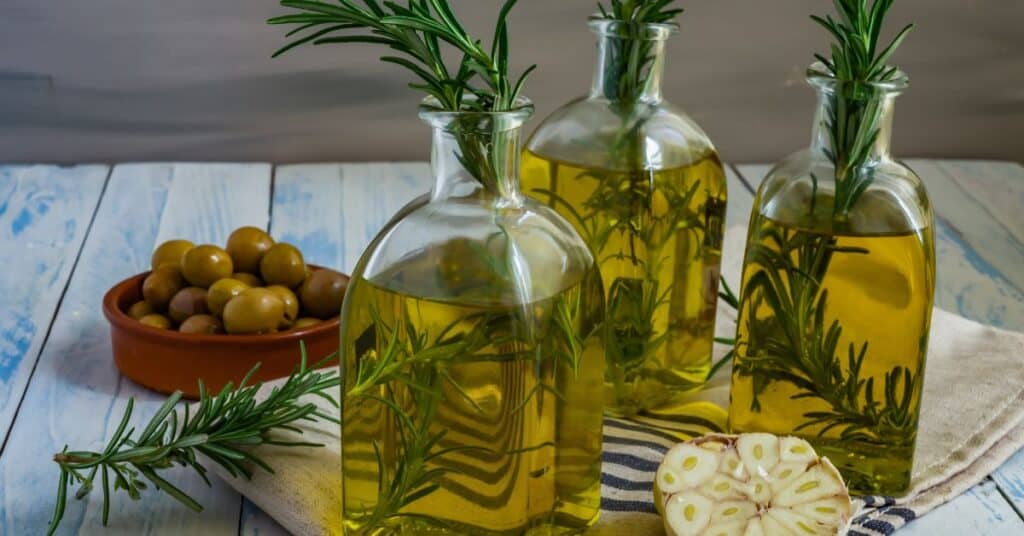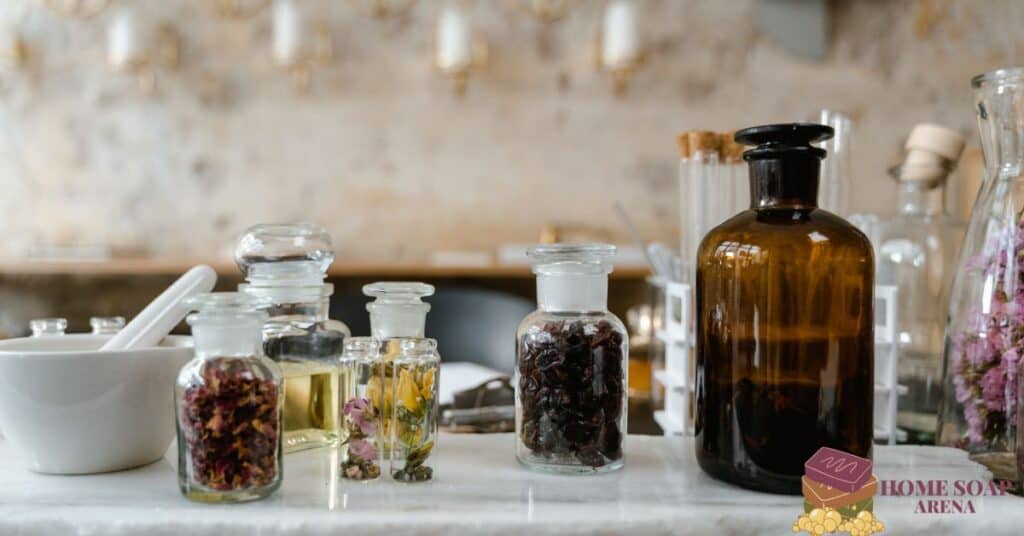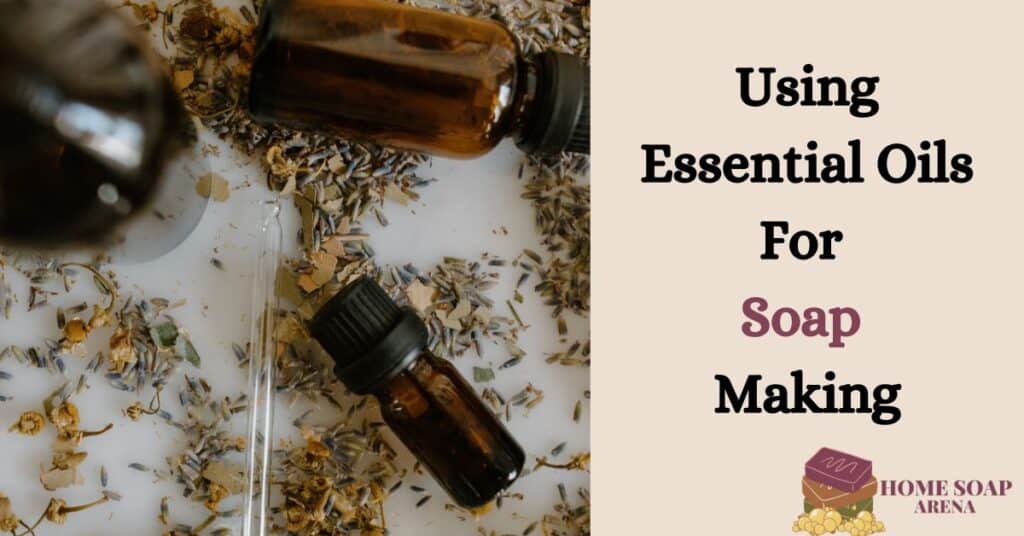Table of Contents
- What Is Oil Infusion?
- What Do You Need To Infuse Oil For Soap Making?
- What Is Oil Infusion Method For Soap Making
- Hot Infusion Method Using A Slow Cooker
- Tincture With Alcohol Oil Infusion Method For Soap Making
- Hot Infusion Method Using A Stovetop
- When To Use Infused Oil In Soap Making?
- What is the difference between essential oils and infused oils?
- Conclusion
Can you use infused oils in soap making? Yes! That is what I will show you in this article.
One way to add extra benefits and fragrance to your soap is by infusing oil with herbs, flowers, or tea.
I love using both lavender and eucalyptus infusions in my soap.
Infused oils are lightly scented and can impart some of the healing properties of the plant material to your soap.
However, there are dos and don’ts to make a potent infusion oil. Additionally, I have successfully used fragrances and essential oils in soaps with infused oils.
Let’s start!
What Is Oil Infusion?
Oil infusion is a process of steeping plant material in oil to extract some of its compounds and transfer them to the oil.
The oil serves as a transport mechanism for the plant’s active components, including antioxidants, vitamins, minerals, and phytochemicals.
Oil infusion can also add a subtle scent and an amazing color to the oil, depending on the type and amount of plant material used.
The soothing qualities of calendula may or may not survive the saponification process, but the infusion does impart a nice, light color to the soap. Try it!
What are the benefits of oil infusion for soap making? Oil infusion can enhance your soap-making in several ways.
First, it can add some of the healing and nourishing properties of the plants to your soap, such as anti-inflammatory, antibacterial, antifungal, moisturizing, soothing, or cleansing effects.
Second, depending on the plants you use, it can add some natural color to your soap, such as yellow, green, orange, or brown.
Third, it can add some natural fragrance to your soap, although this may be minor in cold process soaps, as the scent may fade during saponification.
However, you can always add some essential oils to boost the fragrance if you wish.
How do you infuse oil with Flavour? Infusing oil with flavors is the same process as infusing herbs.
What Do You Need To Infuse Oil For Soap Making?
A carrier oil of your choice. Some of the best-infused oils are olive oil, fractionated coconut oil, jojoba oil, avocado oil, grapeseed oil, and chia seed oil.
These oils have long shelf lives and are suitable for moisturizing and conditioning the skin.
You can also use other oils that suit your soap recipe, such as sunflower, almond, or castor oil. Any form of vegetable liquid oils.
Dried or fresh herbs, flowers, or tea of your choice. Some of the most popular plants for infusing are lavender, rosemary, Arnica, comfrey, chamomile, calendula, mint, lemon balm, rose petals, green tea, black tea, and chamomile tea.
Experiment with other plants that have beneficial properties for the skin, such as nettle, plantain, comfrey, sage, thyme, or basil.
You can use a single plant or a combination of different plants to create your unique blend.
But remember that fresh plants are prone to rancid, mold, or mildew when trying to create these infused oils.
A glass jar with a tight-fitting lid. You can use any jar size, depending on how much oil you want to infuse.
A pint-sized jar can hold about 2 cups of oil, while a quart-sized jar can hold about 4 cups. Make sure the jar is clean and dry before using it.
A coffee filter, cheesecloth, or fine mesh strainer. After the infusion, you will need this to strain the plant material from the oil.
A kitchen scale, measuring cups, and spoons. To measure the oil and the plant material accurately.
A slow cooker, a yogurt mixer, a stovetop, or a sunny windowsill. You will need one of these to heat the oil and speed up the infusion process.
Alternatively, you can use the cold infusion method, which does not require any heat source but takes longer.
What Is Oil Infusion Method For Soap Making
The cold-infusion method is the simplest and most natural way to infuse oil for soap making, but it also takes the longest.
The oil can take 2 to 6 weeks to infuse with the plant material fully.
Advantage: Can you infuse oil without heat? This method preserves the delicate aroma and properties of the plant material without exposing it to high heat or light.
1 If you use fresh herbs or flowers, you must wilt them first to remove some moisture content.
To do this, spread them on a baking sheet or a paper towel and let them air dry for a day or two.
2 You can also use a dehydrator or an oven on low heat to speed up the process. Skip this step if you use dried herbs, flowers, or tea.
3 Chop the plant material to release more of their oils and fragrance. Use a knife, a mortar, a pestle, or a blender to do this.
You don’t need to make them into a fine powder; just break them into smaller pieces.
4 Fill a glass jar with the plant material or fill halfway depending on your preference and how strong you want the infusion to be
2 teaspoons of herbs to 4 oz of olive or coconut oil.
5 Pour the carrier oil over the plant material, covering it completely, and shake it, or use a spoon or a chopstick to stir the mixture and release any air bubbles.
6 Screw the lid tightly on the jar and label it with the date and the contents.
Place the jar in a sunny windowsill and let it sit for 2 to 6 weeks. Shake the jar daily or every few days to help the infusion process.
You can also check the oil’s color and smell to see how it progresses. The oil should gradually take on the plant material’s color and aroma.
When the oil is ready, strain it into a clean glass jar or bottle through a coffee filter, cheesecloth, or fine mesh strainer.
Discard the plant material and store it in a cool, dark, and dry place until ready for soap-making.
Hot Infusion Method Using A Slow Cooker
The hot infusion method using a slow cooker is a faster and easier way to infuse oil for soap making, but it also requires more attention and equipment.
It can take 2 to 5 hours for the oil to infuse with the plant material fully.
Advantage: this method speeds up the infusion process and allows you to make larger batches of infused oil simultaneously.
Here are the steps to follow for the hot infusion method using a slow cooker:
1. Follow steps 1 to 6 of the cold infusion method to prepare the plant material and the oil in a glass jar.
2. Fill the slow cooker with water until it reaches about halfway up the sides of the jar. You can use more than one jar if your slow cooker is large enough.
Ensure the water does not cover the lids of the jars or get inside them.
3. Turn the slow cooker on low and let the oil infuse for 2 to 5 hours. You can check the oil’s color and smell at intervals to see how it progresses.
The oil will gradually take on the plant material’s color and aroma.
4. When the oil is ready, turn off the slow cooker and carefully remove the jar from the water. Let the oil cool slightly before straining it through a filter into a clean glass jar or bottle.
Tincture With Alcohol Oil Infusion Method For Soap Making
This method is considered one of the best ways to make a potent infused oil.
The vodka helps extract the properties of the herbs because the active constituent doesn’t always extract easily into the oil.
You need a yogurt maker that will heat your oil gently as it helps extract nutrients and beneficial constituents from the herbs into the oil.
It’s the right temperature, so you will not fry your herbs if you do not have a yogurt maker substitute for a dehydrator set to 100 or 110 degrees.
To sanitize your equipment, put an Everclear vodka into a spray bottle and spray on your equipment.
Sanitizing equipment ensures that there are no harmful bacteria that will affect the oil. After spraying, let it air dry.
Measurement:
- 1 ounce of chamomile by weight
- Half an ounce by volume
- 7-ounce by volume of vegetable carrier oil
Put 1 ounce of chamomile by weight into a blender and carefully blend until you have a fine powder.
Different herbs can be trickier to blend, and some don’t blend their herbs before infusing them, so whatever works best for you is your call.
Pour the blended herbs into your mason jar, add the vodka, which is half an ounce by volume, and mix with a knife or spoon. Something with less surface area is better.
You do not want it to be wet; a little damp will do. Depending on your herbs, you might need more or less vodka.
Put the jar lid on and let it sit for eight to 12 hours; this way, you allow the herb active ingredient extract into the vodka.
Add your carrier oil and stir with your stirring equipment to ensure the oil well saturates it. Cover and label it with the oil, herb, and date.
Put the jar containing the infused oil in your yogurt maker, plug it in, and let it sit for 3 days. Whenever you think about it, take the jar out and shake it.
This agitation helps extract all of the active ingredients in the herb and then put it back in the yogurt maker at the perfect temperature (100 to 110 degrees).
Then, after 3 days or more, if you forget it won’t hurt, put a filter on a dry jar, pour the infused oil, and squeeze well.
Hot Infusion Method Using A Stovetop
The hot infusion method using a stovetop is another fast and easy way to infuse oil for soap making, but it also requires more attention and equipment.
The oil can take 30 minutes to 2 hours to fully infuse with the plant material.
Advantage: this method speeds up the infusion process and allows you to quickly make smaller batches of infused oil.
1. Follow steps 1 to 4 of the cold infusion method to prepare the plant material and the oil in a glass jar.
2. Fill a small pot with water until it reaches about 3 inches high. Place the jar in the water and make sure the water does not cover the lid of the jar or get inside it.
3. Bring the water to a gentle simmer over low to medium heat(100, maybe 110 degrees) and let the oil infuse for 30 to 2 hours.
You can check the oil’s color and smell every 15 minutes to see how it is progressing.
The oil will gradually take on the plant material’s color and aroma.
4. When the oil is ready, turn off the heat and carefully remove the jar from the water. Let the oil cool slightly before straining it.
The solar infusion method involves placing a jar of oil and herbs in a sunny spot for at least 5 days and then straining the oil.
This method uses the natural heat and light of the sun outside to break down those oils, herbs, and flowers to infuse into the carrier oil.
They will have an opportunity to be heated up in the sun, cooled off at night, and then heat up and cool off.
In about five and five days or so, we can strain off the petals, and then that remaining oil will be perfect for soapmaking.
When To Use Infused Oil In Soap Making?
Oils have different properties that make soap lather, so depending on your soap, you need to consider the properties of your carrier oil.
Olive and coconut oil are the commonly used carrier oils for oil infusion for soap among soap makers because these oils have longer shelf lives.
But that doesn’t negate the fact that other amazing oils can be used to infuse oil for soap-making oils, like soybeans, sunflower, almonds, rice bran, and jojoba oil.
When to use the infused oil is the same as when using other oils in your soap.
Consider this: if you use any of the oils listed above as the carrier oil for your infused oil and want to use that same oil in your soap, the amount of carrier oil you input into soap calc will be the same measurement for your infused oil.
For example, to make a calendula soap, you must use a calendula-infused oil.
Suppose you use coconut as the carrier of the infused oil, which is also one of the oils you want to use in your soap.
In that case, the amount of coconut oil you imputed in a soap calc is the amount of infused oil you are to measure for your soap making because it’s still coconut oil, just that it now contains extra herbal properties.
Suppose you imputed 170 grams of coconut oil in soap calc; then 170 grams of infused coconut oil is what you measure.
What is the difference between essential oils and infused oils?
Essential and infused oils are aromatic oils derived from plants but have different production methods, concentrations, and usage methods.
Here are some of the main differences between them:
Method of production: Essential oils are extracted from the plant material using various processes, such as steam distillation, cold pressing, or solvent extraction.
These processes require a large amount of plant material to produce a small amount of oil.
Infused oils are made by soaking or macerating the plant material in a carrier oil, such as olive oil, coconut oil, or almond oil.
This process requires a small amount of plant material to produce much oil.
Concentration: Essential oils are highly concentrated and potent, containing the volatile compounds that give the plant its smell and therapeutic properties.
Infused oils are less concentrated and mild, containing the non-volatile compounds that give the plant its color and nutritional value.
Usage: Essential oils are mainly used for aromatherapy, as they can affect the mood, memory, and health of the user through inhalation or diffusion.
They can also be used for topical applications, such as massage, skincare, or cleaning, but they must be diluted in carrier oil or water to avoid irritation or toxicity.
Infused oils are mainly used for topical applications, as they can nourish, heal, and protect the skin, hair, or nails.
They can also be used for culinary purposes, such as cooking, dressing, or flavoring, as they are edible and safe to consume.
Note: Just make sure that you get food-grade quality herbs. Secondly, whatever herbs or flowers I use for my oils must be good for my skin.
Conclusion
Infusing oils for soap making is a rewarding process that allows you to add a personal touch to your creations.
By understanding the methods and considerations outlined in this guide, you can embark on a journey of creativity and self-expression in your soap-making endeavors.
So, gather your favorite herbs, choose your carrier oils wisely, and let the art of infusion elevate your soap-making to new heights.



